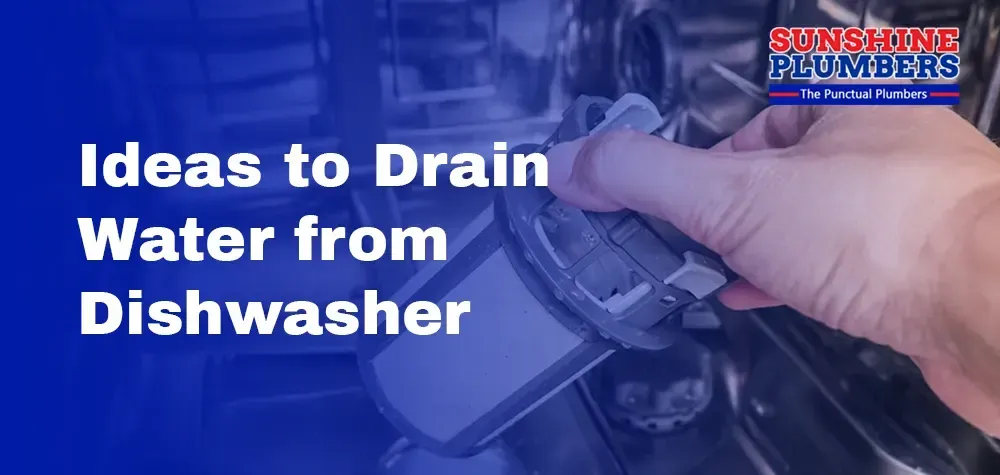Ideas to Drain Water from Dishwasher Properly
The dishwasher is a contemporary kitchen marvel that improves convenience by saving us time and effort. Loading your filthy dishes, pressing a few buttons, and letting the machine handle the work for you is a wonderful feeling. Dishwashers do, however, need routine maintenance and sporadic troubleshooting, just like any other home equipment. The requirement to drain water from the dishwasher is one frequent problem that homeowners may experience. This thorough article will go over the reasons your dishwasher might need to be drained, how to do it properly and provide advice on how to avoid such issues in the future.
Why Do Dishwashers Need Draining?
A built-in drainage system on dishwashers is intended to remove used water after a wash cycle. You might, however, occasionally need to step in and manually empty the water. Here are a few typical explanations:
- Clogged Drainage System:
The dishwasher's filters and drainage system may get clogged with food particles, debris, and grease over time. This might hinder the dishwasher's ability to drain water properly.
- Improper Installation:
Dishwashers can occasionally have improper installation, which results in water collecting at the bottom of the appliance.
- Program Interruption:
A power outage or interruption during a wash cycle can leave water trapped inside the dishwasher, requiring manual removal.
- Routine Maintenance:
As part of regular dishwasher maintenance, you might want to drain any residual water to clean filters and prevent potential odors.
How to Drain Water from Your Dishwasher
Draining water from your dishwasher can be a straightforward process if you follow these steps carefully:
Step 1: Safety First
Before starting anything ensure the power source has been cut off by unplugging the dishwasher. Furthermore, to make sure there aren’t any accidents make sure to unplug the dishwasher or turn the circuit breaker off.
Step 2: Collect the Necessary Tools
To end this project successfully you will need a few supplies and tools:
- A large towel or absorbent rag
- A bucket or a container to collect the drained water
- A screwdriver or wrench (if necessary)
- A pair of gloves
- A flashlight (optional, but it can be helpful in low-light areas)
Step 3: Prepare for Water Spillage
Put a few absorbent rags or a large towel in front of the dishwasher. This will lessen the chance that any water will seep through and harm your kitchen floor.
Step 4: Locate the Drainage System
Hoses, filters, and a drain pump are the standard components of a dishwasher's drainage system. Please refer to your dishwasher's owner's manual for detailed instructions as the locations and layouts of these components may vary depending on the model. Typically, these components are found at the bottom of the dishwasher, behind the kick plate.
Step 5: Remove the Kick Plate
To have access to the drainage system you will need to remove the kick plate from the bottom of the dishwasher. Furthermore, by using a wrench or screwdriver, take the screws out that were holding the kick plate. With caution, take off the plate and reserve it for subsequent reattachment.
Step 6: Check for Water
After removing the kick plate, the dishwasher's bottom ought to be visible. Inspect the area for any standing water. If you notice water pooled at the bottom, you'll need to drain it.
Step 7: Disconnect the Drain Hose
Locate the dishwasher's drain hose. This is typically a flexible hose that connects to the drain pump. To release any trapped water, you'll need to disconnect the hose carefully. This may involve loosening a clamp or simply pulling the hose off the pump or drain point. Be prepared for water to flow into your bucket or container.
Step 8: Drain the Water
With the hose disconnected, allow any standing water to flow into your container. If the water doesn't drain freely, you may need to elevate one end of the dishwasher slightly to encourage drainage.
Step 9: Clean the Filters
During this time, use the chance to clean the filters in the dishwasher. These filters stop trash from getting into the drainage system, but they can clog over time. To find out exactly how to take out and clean the filters, go to your owner's manual. To get rid of dirt and food particles, you usually rinse them under running water.
Step 10: Reassemble
Once you've successfully drained the water and cleaned the filters, reassemble the dishwasher. Reconnect the drain hose securely and fasten the kick plate back into place.
Step 11: Test the Dishwasher
Before turning on the circuit breaker or even before plugging the dishwasher again ensure the reassembling was done accurately. Furthermore, check for leaks as well as proper placement of each component.
Step 12: Power On and Run a Test Cycle
After resolving the issue, plug in your dishwasher or flip the circuit breaker. Verify the water is draining correctly by running a test cycle. This will help confirm that your manual drainage efforts have been successful.
Tips to Prevent Future Drainage Issues
It's usually preferable to avoid drainage issues with your dishwasher rather than fix them. The following advice can help you maintain a smooth dishwasher:
- Regular Maintenance: Clean the dishwasher's filters and check for clogs in the drainage system periodically. This simple maintenance task can help prevent future issues.
- Scrape Plates Before Loading: Scrape off excess food from your plates before loading them into the dishwasher. This reduces the chances of food particles clogging the drainage system.
- Use Quality Detergent: Choose a good quality dishwasher detergent to help prevent soap scum buildup, which can contribute to drainage problems.
- Avoid Overloading: Overloading the dishwasher can prevent proper water circulation and drainage. Follow the manufacturer's recommendations for loading your specific dishwasher.
- Check Installation: If you suspect that your dishwasher's improper installation is causing drainage issues, consult a professional to ensure it's correctly set up.
- Regularly Inspect Seals: Check the door seal and ensure it's in good condition. Damaged seals can lead to leaks that may affect the drainage system.
- Run Hot Water First: Before starting a wash cycle, run your kitchen faucet until the water is hot. The dishwasher will function better as a result of not having to work as hard to heat the water.
Expert Advice on Draining
While emptying the water of your dishwasher is a task that you might need to perform from time to time, drainage problems can be fixed and kept from happening again with the correct knowledge and effort. The key to keeping your kitchen appliance operating efficiently is regular maintenance, correct loading, and attention to the drainage system of the dishwasher. You can guarantee that your dishwasher will remain a time-saving asset in your home and continue to enjoy clean, hassle-free dishes by following the instructions provided in this guide.
Sunshine-Quality Plumbing
When it comes to your plumbing needs, look no further than Sunshine Plumbers. Bringing sunshine into your life with our exceptional plumbing services is the mission of our team of skilled professionals. We can handle any plumbing system installation needs you may have, including clogged drains and faulty faucets. Our dedication to quality, timely service, and affordable prices make us proud. You're choosing more than just a plumbing service when you engage with Sunshine Plumbers; you're choosing great workmanship and peace of mind. Let us be the sunshine in your plumbing experience, so you can enjoy worry-free, reliable plumbing solutions.
At Sunshine Plumbers, we understand that plumbing problems can cast a cloud over your day. Because of this, we're dedicated to offering the most dependable and excellent plumbing services out there. Our highly skilled professionals can easily address any plumbing issue because they have the newest tools and knowledge available. Transparency, honesty, and a job well done are values we uphold. We've built a solid reputation for our dedication to client satisfaction by providing both periodic maintenance and emergency repairs. Trust Sunshine Plumbers to brighten your day with plumbing solutions that keep your home or business running smoothly. Contact us today, and experience the radiance of a plumbing service that truly cares about your needs.




